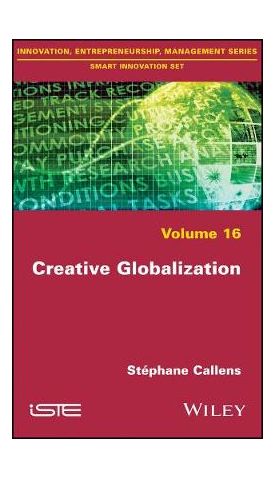אנו משתמשים ב-Cookies כדי לשפר את החוויה שלך. כדי לקיים ההנחיה החדשה של e-Privacy, עלינו לבקש את הסכמתך להגדיר את ה-Cookies. קבלת מידע נוסף.
749.00 ₪
Creative Globalization
749.00 ₪
ISBN13
9781786302274
יצא לאור ב
London
זמן אספקה
21 ימי עסקים
עמודים
242
פורמט
Hardback
תאריך יציאה לאור
1 ביוני 2018
The purpose of this book is to draw up a picture of the transformations in the innovation systems induced by globalization - or globalization. We understand the latter as the existence of new macroeconomic solidarities. These are attested since about the middle of the 1980s, with the observation of a tripolar world drawn up by Kenichi Ohmae.
The book intends to explain all theories of globalization, as well as to clarify its relations with innovation. It constitutes an unprecedented synthesis on this theme, illustrated by examples from many sectors of activity.
| עמודים | 242 |
|---|---|
| פורמט | Hardback |
| ISBN10 | 1786302276 |
| יצא לאור ב | London |
| תאריך יציאה לאור | 1 ביוני 2018 |
| תוכן עניינים | Introduction ix Chapter 1. Globalization and Innovation: An Intellectual Landscape 1 1.1. Globalization: theoretical approaches 2 1.1.1. The "Supply" approach: Kenichi Ohmae 2 1.1.2. The "Political Action" approach: Zygmunt Bauman 5 1.1.3. The "system" approach: Ulrich Beck 8 1.1.4. Theoretical approaches before 1986 14 1.2. Industrial risks in the world: catastrophes 15 1.3. Work accidents around the world 18 1.4. Discussion 25 Chapter 2. Scaling Up 31 2.1. As societies choose 31 2.2. The sociotechnical system of the electric vehicle 33 2.2.1. Light vehicle design 34 2.2.2. Decisive factors in the electric vehicle's acceptability 37 2.3. Inglehart's postmaterialist values 40 2.3.1. Cultural values and the electric vehicle 41 2.3.2. Discussions and implications 47 2.4. Deployment of the electric vehicle and power relations 48 2.4.1. The role of territorial collectives 49 2.4.2. Ulrich Beck's "cosmopolitan communities of climate risk" 50 2.4.3. Individuality with multiple affiliations (Beck) 53 2.4.4. Electromobility 54 2.4.5. Rural and urban areas in the history of electric distribution networks 56 2.4.6. Sustainable territorial strategies: limitations of strategies based on space rationalization 57 2.4.7. "Technological conservatism" versus the "emancipatory catastrophe" 58 2.4.8. Where and how do climate risk communities emerge? 62 2.4.9. Efficiency of local policies 63 2.4.10. The spread of the hydrogen vehicle 64 2.5. The primary electric vehicle markets 66 2.5.1. Pioneering markets 68 2.5.2. Emerging markets 69 2.5.3. Renewal markets 70 Chapter 3. Born Global 73 3.1. Definition 73 3.2. The two worlds of born global organizations 78 3.2.1. Born global firms in regions with a majority of local entrepreneurship 80 3.2.2. Born global firms in open regions 81 3.2.3. A convergence of organizational form 83 3.3. The born global organization: a new paradigm 84 3.3.1. Redesign of the theoretical bases: intellectual rights, learning, intercultural distance 86 3.3.2. An entrepreneurial paradigm of simplicity 87 3.4. Collaborative economics and born global organizations 89 3.4.1. Creative destruction? 90 3.4.2. Collaborative economics and the dynamics of civic spirit 92 3.5. An economy of remoteness 96 3.5.1. Birth of the unicorn 97 3.5.2. The benefits of remoteness 98 Chapter 4. Penpushers and Hotheads 101 4.1. The curse of the company leader 101 4.2. The behavioral finance of attractiveness 103 4.2.1. Models with "heuristics and biases" 104 4.2.2. Models with preference formation 106 4.2.3. Coordination models 107 4.2.4. Argument and limits 108 4.3. The behavioral finances of venture capital 109 4.3.1. Models with heuristics and biases 112 4.3.2. Preference formation models 116 4.3.3. Coordination outside the market 117 4.3.4. The contribution of behavioral approaches to the analysis of venture capital 119 Chapter 5. Innovation and Freedom of Circulation 121 5.1. From the dilemma to the trilemma of Myrdal 121 5.1.1. Innovation systems in globalization: a comparison of 1997/2017 123 5.1.2. Common markets: two, three and four freedoms 125 5.1.3. Innovation, spatial or social segregation in common markets 128 5.2. Multilateral management 133 5.2.1. Migration, wage and commerce: a review of the literature 135 5.2.2. Citizenship around the world 139 5.2.3. Institutional outlines of multilateral management 147 5.2.4. Citizenship and innovation 148 Conclusion 153 Bibliography 171 Data sources 189 Index 193 |
| זמן אספקה | 21 ימי עסקים |



Login and Registration Form